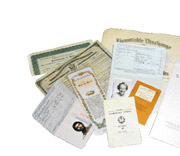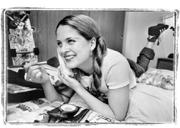THE AUCTION TAKES PLACE inside a cavernous fluorescent-lit warehouse on the edge of Lake City; 2,800 lots are slated to be sold. The lots consist of items retrieved from abandoned safe-deposit boxes. The Department of Revenue, which will profit from whatever money the auction brings in, has attempted through various means to find the owners of these abandoned items, but the owners seem to have disappeared. The boxes have moldered in bank vaults throughout the state, rents unpaid. Now the boxes have been drilled open, their private contents brought out into the light. These contents include: love letters, stamp collections, bank statements, passports, broken hearing aids, war medals, property deeds, teeth, a thousand Last Will and Testaments, enough silver dollars to sink a battleship.
My husband and I arrive when the doors open. We’re part of the first large throng of buyers, a population that will reconstitute itself depending on the time of day and the items being auctioned. In the morning, items rumored to be “valuable” will sell for as high as $700—watches, jewelry, silver spoons. Later, around 7pm, “scattered papers” will go for $2.50 a lot or less, to a small, rapidly diminishing crowd.
Although there are a few curiosity seekers, an alarming number of media types (John Curley ironed and in full makeup), and some scattered buyers who appear wealthy (a lady in leather and fur with her red-faced boyfriend, bidding on jewelry), the majority of the people here seem manifestly down-and-out. This is the same tribe you see in casinos, a distinct group marked by an alcoholic weariness and an aura of reckless hope. They’re treasure-seekers who have heard the jackpots calling their names too many times. They’re similar to characters you see on beaches, poised over the sand with metal detectors.
“Can I hear 20 Can I hear 20 HUP 20 20 20, OK 25 I heard 25 and can I hear 30 30 30 YUP 35 35 35 NOPE!” The auctioneer’s voice is an aggressive lullaby, holding the crowd in a trance. When an item has found its new owner, he declares, “All done all through!” with great authority. As the day progresses, I will come to admire everything about the auctioneers: their laid-back control, how they never break a sweat, how they swiftly apologize if someone’s bid is misinterpreted or overlooked.
When we entered the warehouse we agreed “no bidding.” Neither of us has any cash to spare, and we’re in the process of clearing out the closets at home, overwhelmed by our own collections of debris: report cards, miserable birthday photographs, pictures of kids who we can’t place. “The last thing we need is someone else’s stuff!” I tell my husband confidently. But as we watch the items being ferried in and out, as more and more things pass us by, going to another “lucky buyer,” we start feeling anxious, thirsty. We want to bid. We comb through the 51-page catalogue, looking for the abandoned object that might be calling to us.
This is how the spell of the auction works: It causes you to cross over into the zone where money doesn’t matter, where money is like a word you say over and over until it doesn’t make sense anymore, until it’s just a sound. I have succumbed to this feeling many times sitting in front of slot machines in Vegas, and my husband knows it. He looks at me warily. He suggests maybe I need to take a walk outside and get a Coke.
Only a fraction of the items on the block are actually on physical display in the auction room. Mostly they’re held in a remote location and broadcast on TV. There are three large screens at strategic points in front of the buyers. You can see a lady’s hands laying the item down on a plush background. Some who are thinking about bidding move close to the screen, peering into it. “God,” one leather-skinned lady says, “I wish I could just pick it up so I would know what I am getting!”
You must follow the lot numbers by reading the catalogue. The catalogue is a truly remarkable, inadvertently poetic text:
Item #9 POCKET WATCH FROM MEMBERS OF PARLIAMENT TO DAVID DAVIES IN RECONGITIN [sic] OF HIS BREVERY [sic] IN SAVING LIFE AT THE TYNEWOOD COLLIERY APRIL 1877
Item #1199 LOOSE STONES, TEETH, CUFF LINKS, JEWELRY, BELT BUCKLE AND ASSORTED PAPERS
Item #1103 PANNED GOLD
Item #611 ASSORTED KNICK KNACKS
Item #925 VERY LARGE LIGHTER
Item #917 is a “Letter signed by Henry Ford II.” It’s one of the few items laid out on tables in the room where the auction takes place, so it can be closely examined by potential buyers. Written on a piece of official Ford Co. stationery and dated October 24, 1977, the letter is addressed to Madeline Lee Campbell of Tacoma. The body of the letter reads:
Thank you for your note, the newspaper clipping, and the gift of cuff links. It was very nice of you to do this and I appreciate your thoughtfulness.
Sincerely,
Henry Ford
“There has been much interest in this item,” according to the auctioneer. It will eventually sell for $40.
The first lot we agree to bid on comes late in the day, a “desk set with globes.” We have not actually laid eyes on this mythical desk set, nor will we before we buy it, since it’s part of a cluster of lots being sold quickly at the end of the day. But we figure, well, globes, that’s nice. Everyone needs a globe. By now we’re completely engrossed in the drama of the room, the competition among buyers. We’ve started to believe that the people who come away with an item have “won” something. We’ve started to believe there’s something here worth fighting for. Two men fiercely bid for an “Indian Purse.” One finally concedes, then turns around his chair to face his opponent: “I hate you!” he says. “I’m going home.”
When we’re awarded the “Desk set with globes” for $30, we become irrationally excited. I clutch my husband’s arm as if we’re contestants on a game show. The auctioneer looks at us affectionately. We’re no longer tourists of the auction, we’re citizens of it.
The last lots of the day consist of various “ASSORTED PAPERS,” These go for $2.50 each or less, sold in clusters to speed up the process. My husband and I purchase nine sets, sight unseen. A young hippie with a sweet smile, sitting a few rows in back of us, buys something like 50 lots. “Well I brought my truck, so I guess I can get ’em all home,” he reasons. “Well, you’ll have fun with this stuff,” promises the auctioneer.
When all these final pieces of debris have been sold, we stand in line at the cash register. A man in a frayed flannel coat has spent $550. “I can’t believe it!” he says. “This reminds me of the time I bought a mobile home for two thousand bucks!” he says. “Yeah,” counters his wife, “and then it cost five thousand bucks to move it!”
Our desk set, plus nine sets of assorted papers, plus a nine percent “buyer’s premium,” puts us back 70 dollars. Our purchases are handed to us in a cardboard banker’s box. We drive home through the dark. Although we’re starving, we don’t stop to eat; we’re too anxious to see what we’ve come away with. Just as we needed to buy it, now we need to see it.
At home we empty the box on the kitchen table. The globes are plastic paperweights with a DHL logo decorating them, far from the rare antiques we saw in our mind’s eye when we bid and won. Disappointed, we open the plastic bags containing the assorted papers. It has now been over a week, and as of this writing we have still not finished this process of sifting. It’s unclear whether we’ll ever finish.
If the globes have been relegated to the junk heap, the papers have taken a central place in our lives. They have unsettled us and changed us, given us vivid dreams, filled our house with unfinished stories. One set of documents seems to belong to a man who changed his identity: a driver’s license with a different name than a passport, canceled checks bearing the new name. In another set, there’s a certificate of Honorable Discharge and a high school diploma. In another, an incomplete and frustratingly elusive set of love letters written on World Health Organization stationery. One letter declares, “I understand you are upset but I am not sure you can blame me for something you yourself have created.” Perhaps the saddest lot of all, #1399, simply contains a glasses case and a “Certificate for Transfer of Dog” carefully preserved in a manila envelope.
Where are the lovers, and where is the transferred dog? We’re like detectives with a hopeless case, unsure what to do with all this evidence leading nowhere. I’ve suggested perhaps we wallpaper a room with the wills and diplomas, but my husband says, “too creepy.” We feel something has been handed over to us that we need to preserve, but why? In case some lost soul appears on our doorstep, asking for their driver’s license? We cannot help but wonder: Who do these things belong to? Furthermore, what does it mean if they belong to us?






